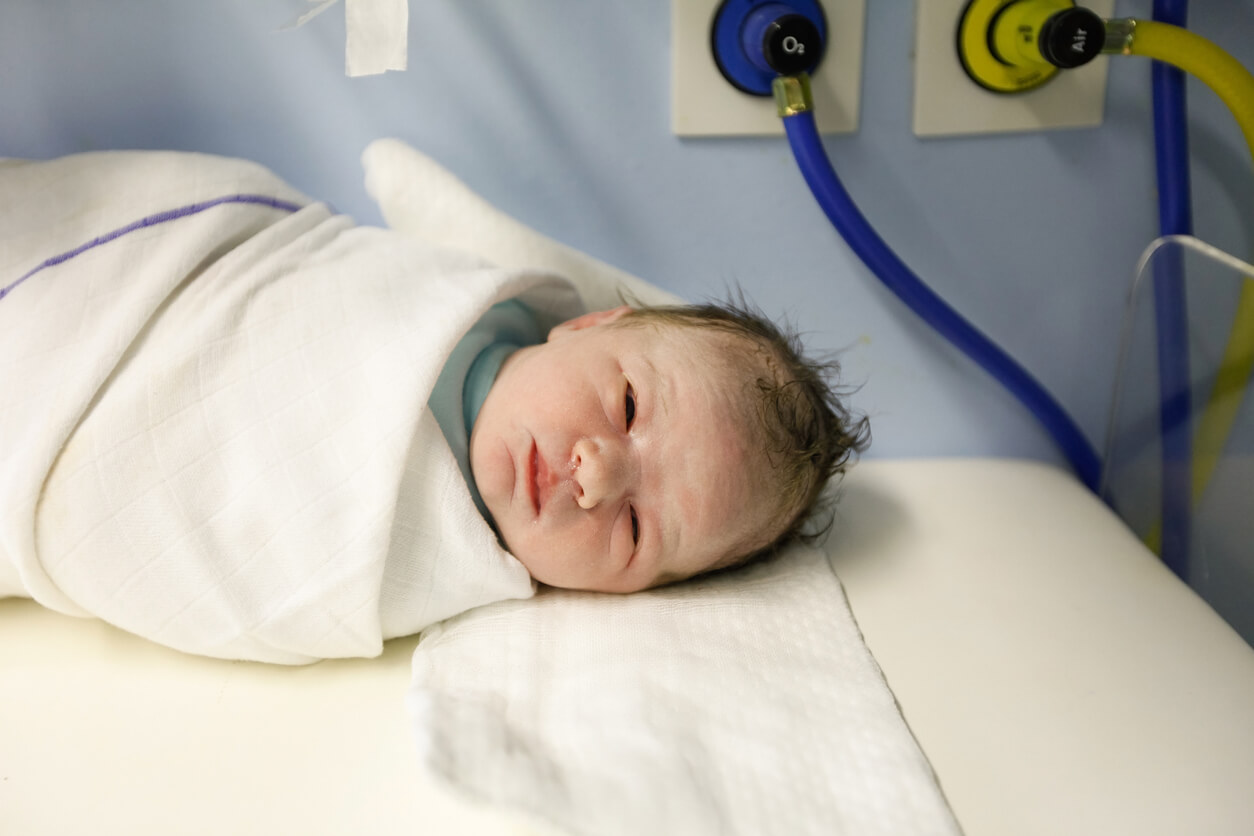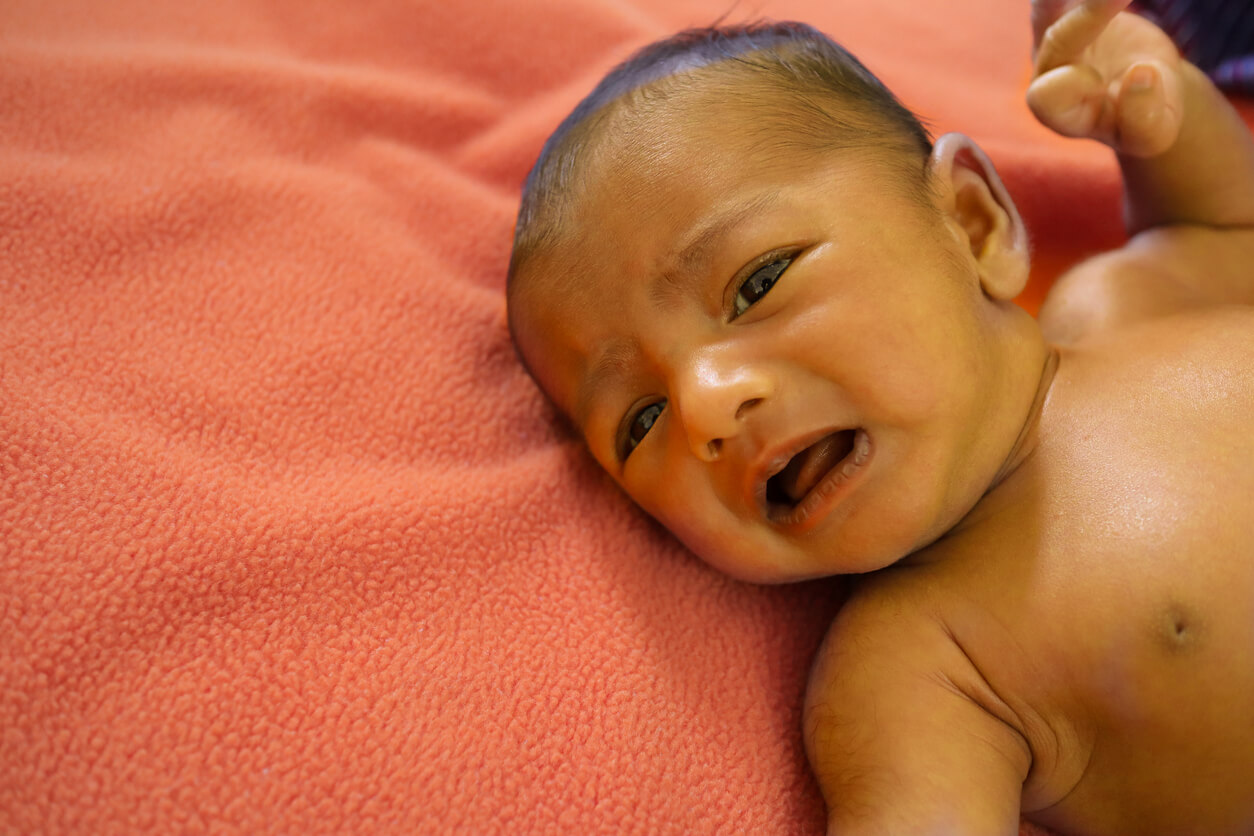Fetal Lanugo: What You Should Know


Written and verified by the dermatologist Maria del Carmen Hernandez
Fetal lanugo is a type of thin, fine hair in newborns that shouldn’t cause concern in parents, as it disappears spontaneously after a few days. However, it often manifests itself on other occasions that shouldn’t be ignored. Here’s everything you need to know about it.
What is fetal lanugo?
Lanugo is a type of soft, fine, unpigmented hair that’s most commonly found in newborns, fetuses, and in certain pathological conditions. However, its presence in neonates is a normal finding. In fact, lanugo is essential to ensure the normal development of the fetus. However, in adults, it may be a manifestation of some underlying disease.
Lanugo is the first hair variant to develop in humans. Thus, it arises around three months of intrauterine development, according to an article from the Cleveland Clinic.
Stages of development
Hair growth begins on the scalp around the nose, eyebrows, and forehead area. It then progresses in a cephalocaudal direction toward the feet. However, the palms, soles of the feet, and lips don’t have it. Then, in the course of time, it’s naturally eliminated between 33 and 35 weeks of gestation, at which time it’s incorporated into the amniotic fluid. However, in 30% of newborns, it usually remains and is a normal finding.
Finally, it forms part of the meconium and is replaced on the skin surface by vellus hair (very fine, short hair) and terminal hair (longer, coarser hairs located on the genitals, armpits, and scalp).
You may be interested in: Keys to Keeping Your Baby’s Skin Moisturized

Functions of fetal lanugo
Fetal lanugo plays an important role in the attachment of vernix caseosa and the skin surface of fetuses. Vernix caseosa is the white, viscous substance of the newborn that protects the skin, prevents water loss, aids in thermoregulation and supports the immune system. It also protects the fetus from aggressive substances found in the amniotic fluid, such as electrolytes and urea.
Read also: Infant skin
care
Pathological manifestations of fetal lanugo
Fetal lanugo can occur in the newborn during the first weeks of life. However, its manifestation can be by premature birth. Also, when present in adults, it can be a sign of complex underlying pathologies. Therefore, when there is suspicion that it is due to other diseases, a more complete systemic study is required. The severity of the pathology may even correlate with the amount and distribution of lanugo presence.
Anorexia nervosa
In eating disorders, an incipient lanugo may manifest itself due to nutritional deficits that develop insufficient body fat. Consequently, it is generated as a natural or physiological response to insulate the body, as there is not enough body fat to keep the body warm.
Bulimia nervosa
As in anorexia nervosa, the body tries to take care of itself and keep its temperature regulated and constant through the development of lanugo on the skin surface. In these cases, treatment begins with appropriate management of the underlying health problem. That is, with nutritional and psychological counseling, support groups and medication prescribed by a physician.
Different forms of malnutrition
Because fetal lanugo provides protection to the body and skin, in malnourished people, it tends to grow on the face and body over time.

Should fetal lanugo be treated?
Fetal lanugo in a newborn baby doesn’t require therapeutic management. Even when there’s a lot of hair at the time of birth, it’s not a reason to worry, as this hair will be lost naturally as the days go by. One of the options to help loosen and remove lanugo is a gentle massage. However, this is also unnecessary, as rubbing the skin too hard can cause pain, dryness, or erythema.
Fetal lanugo is a transient condition
Fetal lanugo in newborns shouldn’t be a cause for concern, but if there you do have concerns, don’t hesitate to consult your healthcare provider. In adults, the presence of lanugo may be a sign of an eating disorder or underlying disease that shouldn’t be ignored.
Fetal lanugo is a type of thin, fine hair in newborns that shouldn’t cause concern in parents, as it disappears spontaneously after a few days. However, it often manifests itself on other occasions that shouldn’t be ignored. Here’s everything you need to know about it.
What is fetal lanugo?
Lanugo is a type of soft, fine, unpigmented hair that’s most commonly found in newborns, fetuses, and in certain pathological conditions. However, its presence in neonates is a normal finding. In fact, lanugo is essential to ensure the normal development of the fetus. However, in adults, it may be a manifestation of some underlying disease.
Lanugo is the first hair variant to develop in humans. Thus, it arises around three months of intrauterine development, according to an article from the Cleveland Clinic.
Stages of development
Hair growth begins on the scalp around the nose, eyebrows, and forehead area. It then progresses in a cephalocaudal direction toward the feet. However, the palms, soles of the feet, and lips don’t have it. Then, in the course of time, it’s naturally eliminated between 33 and 35 weeks of gestation, at which time it’s incorporated into the amniotic fluid. However, in 30% of newborns, it usually remains and is a normal finding.
Finally, it forms part of the meconium and is replaced on the skin surface by vellus hair (very fine, short hair) and terminal hair (longer, coarser hairs located on the genitals, armpits, and scalp).
You may be interested in: Keys to Keeping Your Baby’s Skin Moisturized

Functions of fetal lanugo
Fetal lanugo plays an important role in the attachment of vernix caseosa and the skin surface of fetuses. Vernix caseosa is the white, viscous substance of the newborn that protects the skin, prevents water loss, aids in thermoregulation and supports the immune system. It also protects the fetus from aggressive substances found in the amniotic fluid, such as electrolytes and urea.
Read also: Infant skin
care
Pathological manifestations of fetal lanugo
Fetal lanugo can occur in the newborn during the first weeks of life. However, its manifestation can be by premature birth. Also, when present in adults, it can be a sign of complex underlying pathologies. Therefore, when there is suspicion that it is due to other diseases, a more complete systemic study is required. The severity of the pathology may even correlate with the amount and distribution of lanugo presence.
Anorexia nervosa
In eating disorders, an incipient lanugo may manifest itself due to nutritional deficits that develop insufficient body fat. Consequently, it is generated as a natural or physiological response to insulate the body, as there is not enough body fat to keep the body warm.
Bulimia nervosa
As in anorexia nervosa, the body tries to take care of itself and keep its temperature regulated and constant through the development of lanugo on the skin surface. In these cases, treatment begins with appropriate management of the underlying health problem. That is, with nutritional and psychological counseling, support groups and medication prescribed by a physician.
Different forms of malnutrition
Because fetal lanugo provides protection to the body and skin, in malnourished people, it tends to grow on the face and body over time.

Should fetal lanugo be treated?
Fetal lanugo in a newborn baby doesn’t require therapeutic management. Even when there’s a lot of hair at the time of birth, it’s not a reason to worry, as this hair will be lost naturally as the days go by. One of the options to help loosen and remove lanugo is a gentle massage. However, this is also unnecessary, as rubbing the skin too hard can cause pain, dryness, or erythema.
Fetal lanugo is a transient condition
Fetal lanugo in newborns shouldn’t be a cause for concern, but if there you do have concerns, don’t hesitate to consult your healthcare provider. In adults, the presence of lanugo may be a sign of an eating disorder or underlying disease that shouldn’t be ignored.
All cited sources were thoroughly reviewed by our team to ensure their quality, reliability, currency, and validity. The bibliography of this article was considered reliable and of academic or scientific accuracy.
- Cabetas Hernández I. Desnutrición en Anorexia Nervosa: enfoque psicosomático y tratamiento multidisciplinar [Malnutrition in anorexia nervosa: psychosomatic approach and multidisciplinary treatment]. Nutr Hosp. 2004 Jul-Aug;19(4):225-8. Spanish. PMID: 15315113.
- Bamalan OA, Menezes RG. Vernix Caseosa. [Updated 2021 May 9]. In: StatPearls [Internet]. Treasure Island (FL): StatPearls Publishing; 2021 Jan-. Available from: https://www.ncbi.nlm.nih.gov/books/NBK559238/
- Pardi G, Cetin I. Human fetal growth and organ development: 50 years of discoveries. Am J Obstet Gynecol. 2006 Apr;194(4):1088-99. doi: 10.1016/j.ajog.2005.12.056. PMID: 16580300.
This text is provided for informational purposes only and does not replace consultation with a professional. If in doubt, consult your specialist.








